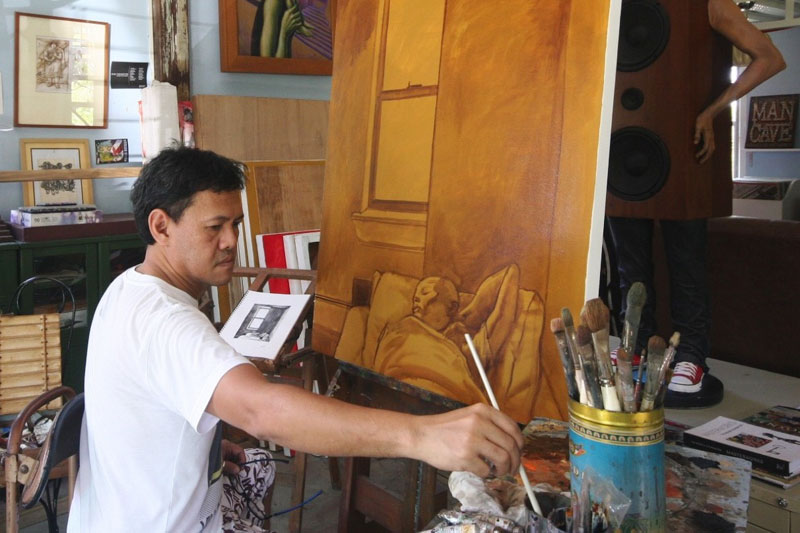Elmer Borlongan and the quiet strangeness of being

Elmer Borlongan has painted slices of life in the Philippines with both urban and rural themes. As the artist turns 51, the show “An Extraordinary Eye for the Ordinary” at the Met presents his works from 1979 to 2015, with some pieces shown to the public for the first time.
MANILA, Philippines — Elmer Borlongan’s cast of strange characters has by now become some of the most familiar figures in the realm of local paintings. There are the armless guitar players, the blind leading the blind, the man whose gaze is just as ominous and enigmatic as the sky beyond him. Upon seeing his works that have found residence in many private collections, we’d easily recognize where the characters were culled: from the streets of Manila, from the shores of Zambales — made bent, made gaunt, made strange by the artist’s hand and imagination.
The painter has just turned 51 this January. “Two years ago, a friend suggested I do a survey show of my 25-year career as an artist. We’re also doing a coffee-table book of my works,” says Borlongan, further sharing that in 2015, he and his wife, artist Plet Bolipata, moved back temporarily to Manila to prepare for the show and the book production. The two-year wait culminates in an exhibit entitled “An Extraordinary Eye for the Ordinary.” The Metropolitan Museum of Manila has assembled 200 of the artist’s works, made in the span of 1979 to 2015, curated by historian Ambeth Ocampo, and running until March 28.
A figurative expressionist influenced by the styles of Carlos Botong Francisco, Onib Olmedo, Danilo Dalena, and Jaime de Guzman, Borlongan has always favored subtle distortions over naturalistic depictions, exploring the quiet deformations that light and lines exert on the human figure.
One of the largest paintings displayed in the exhibit, “Pag-Ahon” (2011) is a 7.5-by-15-foot work depicting identical-looking figures who pull to shore a banca after a day of fishing, doing the toil of workers in a painting plane where they are giants. Some heads are bent in seeming meditation; one howls and the sky seems to respond with undulating waves of light and rhythm. “It was a dream project,” says the artist. “This image was going through my head for a long time to paint in this scale. This is my version of bayanihan.”
Borlongan’s subject matter has often courted associations with social realism, owing largely to the volatile political climate that provided a backdrop to his art education: He took up early art lessons with Fernando Sena during the days of martial law, dropped his UP degree and painted murals after the EDSA revolution, and joined political art collectives such as Artista ng Bayan (ABAY), Salingpusa, and Sanggawa.
“The works I did in Manila were dark,” says Borlongan. “The paper and canvas are divided into geometric shapes to define spaces within the city. There is isolation and fear. Streets are crowded and pavements are cold.” His subjects are often the common man we see on the street: the boy with the Coke, the crippled musicians — familiar oddities coughed up by the everyday dissonance we experience in the country. Borlongan would render them with both strangeness and humor, his distortions lending an air of caricature-like unreality to Manila’s absurdities we’re all too accustomed to.
His later works, succeeding his move from Manila to Zambales with Plet in 2002, acquired a lighter tonal language. “There were more open spaces in the countryside,” he says. “My palette became lighter. The subject matters in my paintings are people working in the rural areas. I painted their religious processions. I became introspective.”
Their house in Zambales is tucked in the middle of a mango farm and adjacent to Casa San Miguel which is home to musicians, visiting artists, and children eagerly practicing their violins and solfeggios. We could say there is a palpable sense of freedom in the place, of time standing still — although, the artist quips, “My painting routine is like office hours.” He wakes up at six or seven in the morning every day, draws and paints after breakfast until noon, has lunch with Plet, and continues painting so long as there is natural light. While the artist follows a strict schedule, he says, “I don’t feel time is moving when I am painting while listening to music.”
Giving a peek into the place where his art is created, the show at the Met likewise presents a reconstruction of his studio and part of their living room in Zambales, as well as drawings in different media to hint at the artist’s painting process.
Close to the sea, Borlongan paints his characters with elements closer to the natural world. Set against a wide expanse of clouds, trees, and animals, Borlongan’s characters stand like powerful figures lording over the pictorial plane, commanding the sea’s rhythms instead of simply being suspended in its song.
Throughout varying periods and settings, what has remained the mark of Borlongan is the strong expression of the human face. Removed from their social context, or adrift in fluid time, their eyes still carry that so-called weight of being, or as the artist puts it, “The figures in my paintings do not have different expressions but the eyes can’t hide it.” Odd figures, amid distortions and an air of otherness and dissonance, stare out us and command contact.
“I want to portray my subjects with hope,” he says, “that they still have the capacity to survive despite the situation they’re in.” Borlongan’s figures, whether on the street or on the shore, are depicted rising above the place and time in which they’re set — the soft deformations estranging the familiar, and in turn making relatable and striking and human what is strange. As Borlongan has turned half a century old, the show pays tribute to the artist’s life, and to Borlongan painting the quiet strangeness of being here.



















